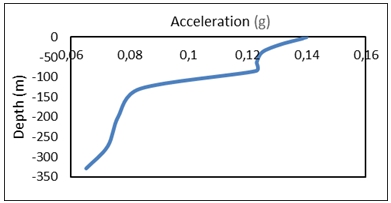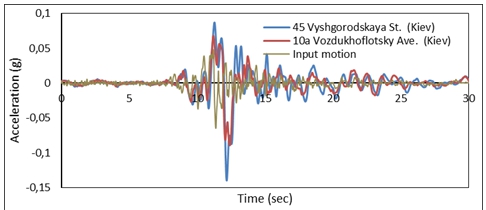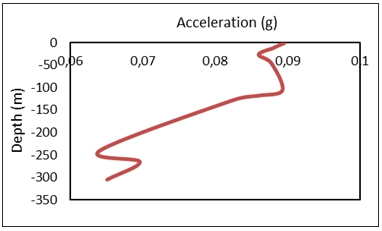COMPARISON OF THE SIMULATED PEAK GROUND ACCELERATION AT DIFFERENT SITES LOCATED CLOSE TO EACH OTHER
СРАВНЕНИЕ МОДЕЛИРУЕМОГО ПИКОВОГО УСКОРЕНИЯ ГРУНТА НА РАЗНЫХ УЧАСТКАХ, РАСПОЛОЖЕННЫХ БЛИЗКО ДРУГ К ДРУГУ
Научная статья
ORCID: 0000-0003-4628-8663,
Институт геофизики им. С.И. Субботина НАН Украины, Львов, Украина
* Корреспондирующий автор (ulaska[at]ukr.net)
АннотацияВ работе рассматривается проблема того, насколько различаются пиковые ускорения при одном и том же входном движении (в виде акселерограммы) на разных площадках, расположенных близко друг к другу. Представлены результаты моделирования трансформации одного и того же входного движения почвенными слоями двух разных участков. Участки имеют похожую геологическую структуру. Коренные породы находятся на одной глубине. В таких условиях при проектировании сейсмостойких объектов инженеры-конструкторы для расчетов сочетания аварийных нагрузок обычно используют один и тот же набор проектных акселерограмм. Результаты моделирования, представленные в этой статье, показали, что трансформация одного и того же входного движения грунтами, близко расположенных участков с похожей геологией, существенно отличается.
Ключевые слова: сейсмическое микрорайонирования, расчетные акселерограммы, пиковое ускорение грунта.
COMPARISON OF THE SIMULATED PEAK GROUND ACCELERATION AT DIFFERENT SITES LOCATED CLOSE TO EACH OTHER
Research article
Semenova Yu. *
ORCID: 0000-0003-4628-8663,
Institute of Geophysics of the National Academy of Sciences of Ukraine, Lviv, Ukraine
* Corresponding author (ulaska[at]ukr.net)
AbstractThe paper considers the problem of how different the peak acceleration at the same input motion (in the form of an accelerogram) at different sites located close to each other. The results of modeling the transformation of one and the same input motion by the soil strata of two different sites are presented. The sites have a similar geological structure. The bedrock is at the same depth. Under such conditions, when designing seismic resistant objects, design engineers for emergency load combination calculations usually use the same set of design accelerograms. The simulation results presented in this article showed that the transformation of the same one input movement by the soils of closely located sites with similar geology, differs significantly.
Keywords: seismic microzoning, designed accelerograms, peak ground acceleration.
IntroductionWhen testing buildings and structures for seismic effects by direct dynamic methods, accelerograms of earthquakes with characteristics corresponding to a specific construction site are required [1].
For the direct dynamic method of determining seismic loads at the stage when the object is not tied to a specific site, SBS V.1.1-12: 2014 [2] recommend accelerograms for testing. In practice, these accelerograms are sometimes mistakenly used for specific construction sites. The use of calculated accelerograms, which do not take into account the filtering properties of soils at a specific site [3], leads to incorrect engineering calculations of the seismic resistance of buildings.
The paper considers the problem of how different the peak ground acceleration at the same input motion (in the form of an accelerogram) at different sites located close to each other within the same city. The research was carried out using mathematical modeling software product ProShake [4], [5]. The calculation is based on the requirement of taking into account not one possible seismic impact, but an ensemble of impacts with different spectral characteristics, determined by the location of zones of possible earthquake focus relative to the site under study [6]. Seismic effects are represented by an ensemble of accelerograms were recorded on bedrock deposits or recalculated to bedrock [7].
When modeling the effect of soil layers on seismic effects, one should take into account data on tectonics, lithology, boundary geometry, as well as physicomechanical and nonlinear properties of the soil at the site. [8], [9], [10].
Main results
In fig. 1 presents the results of modeling the horizontal components of the calculated accelerograms obtained as a result of recalculation from the bedrock to the surface of the building sites at 45 Vyshgorodskaya St. and 10a Vozdukhoflotsky Ave. in Kiev. For both sites, the calculations used the same input motion in the form of an accelerogram was recorded on bedrock with maximum peak acceleration (PGA) PGA = 0.07g.
Soil strata under the site at 45 Vyshgorodskaya St. is mainly composed of sands and sandy loams, from 10 m to 85 m there are inversion layers of sandy loams (layers with reduced speeds). In the soil strata under the site at 10a Vozdukhoflotsky Ave. there are mainly sands and clays. Also at a depth of 26 m to 106 m there are inversion layers of clay with layers of water-saturated sand.
Fig. 1 – The horizontal components of the calculated accelerograms recalculated from the bedrock to the ground surface of the sites at 45 Vyshgorodskaya St. and 10a Vozdukhoflotsky Ave. in Kiev. Input ground motion with PGA of 0.07 g
Fig. 2. and Fig. 3 show the PGA versus depth curve of the same input motion at different sites at 45 Vyshgorodskaya St. and 10a Vozdukhoflotsky Ave. in Kiev.
 Fig. 2 – Comparison of the PGA in the different depths at 45 Vyshgorodskaya St. in Kiev
Fig. 2 – Comparison of the PGA in the different depths at 45 Vyshgorodskaya St. in Kiev
Fig. 3 – Comparison of the PGA in the different depths at 10a Vozdukhoflotsky Ave. in Kiev
In Figure 2 and Figure 3 shows how PGA of seismic fluctuations change along depth during the same input motion at different construction sites at 45 Vyshgorodskaya St. and 10a Vozdukhoflotsky Avenue in Kiev. The depth to bedrock under both construction sites is about 330 m. At this depth, the PGA of the input motion is 0.07g. Under the site at 10a Vozdukhoflotsky Avenue, PGA decreased from 0.0889 g to 0.086 g at a depth of 105 m to 25 m. Further, in the upper 25-meter layer, it again increased to 0.090 g. Under the site at the 45 Vyshgorodskaya St. PGA smoothly increased to 0.076 g from a depth of 330 m to 198 m. From a depth of 198 m to 84.5 m, there is a rapid increase in PGA from 0.076 g to 0.123 g. Further, from 84.5 m to 36 m, the PGA slightly changes to 0.125 g, after which a rapid increase to 0.14 g is again observed.
Despite the fact that both sites are located in the same city and the distance between them is only 10 km, the soil strata of each of the sites transform the input motion according to different scenarios.
Analysis of the results presented in Figure 2 and Figure 3 allows us to make sense of the conclusions that the direct dynamic method for calculating seismic effects requires computational accelerograms that simulate earthquakes from hazardous areas of the zones of possible earthquake focus site, generated on the basis of observed accelerograms or recalculated to the bedrock as well as a seismic-geological model of the soil strata under the study site. The model will allow to take into account possible resonant and non-linear properties of soils. In real records of weak and medium-sized seismic events, nonlinear effects do not appear.
When constructing a computational seismic geological model for mathematical modeling of the effect of the soil strata on seismic effects, data on tectonics, lithology, boundary geometry, and physical-mechanical and non-linear soil properties of the site should be taken into account. On the other hand, calculations are limited by the capabilities of computational algorithms. In each case, it is necessary to find the optimal relationship between the complexity of the computational model of the geological environment and the capabilities of computational algorithms for calculating the movement of soil particles in complex models of the environment during earthquakes.
Conclusion
The article presents the results of modeling the transformation of one and the same input motion by the soil strata of two different sites. The sites have a similar geological structure. The bedrock is at the same depth. Geographically, the sites are located at a distance of 10 km from each other in Kiev on the right bank of the Dnieper. Under such conditions, when designing seismic resistant objects, design engineers for emergency load combination calculations usually use the same set of design accelerograms. The modelling results presented in this article showed that the soil amplifications of the same input motion, even on closely spaced and, at first glance, sites with similar geological structure, may differ significantly.
Thus, for the direct dynamic method of calculating seismic effects, it is necessary to use the calculated accelerograms were obtained for a specific construction (operational) site. Such accelerograms are generated using a calculated seismic geological model of the soil strata of the specific site and accelerograms recorded on bedrock (or recalculated from them) from hazardous areas of the zones of possible earthquake focus site.
Calculated accelerograms should be generated only for specific sites of the proposed seismic resistant construction. Their use will ensure an acceptable level of seismic resistance while reducing the cost of the object. The use of accelerograms, which do not take into account the resonant and nonlinear properties of soils at a specific site under study, can lead to incorrect engineering calculations of the seismic resistance of buildings.
| Конфликт интересов Не указан. | Conflict of Interest None declared. |
Список литературы / References
- Kramer S. L. Geotechnical Earthquake Engineering / Kramer S. L. N. J.: Prentice Hall, Upper Saddle River. 1996. - 672 p.
- Строительство в сейсмических районах Украины: ДБН В.1.1-12:2014. Киев: Минрегионстрой Украины, 2014. 84 с.
- Ishikhara K. The behavior of soils during earthquakes / Ishikhara K. St. Petersburg: NPO «Georekonstruktsiya-Fundamentproekt». - 383 p.
- Schnabel P. B. SHAKE: A computer program for earthquake response analysis of horizontally layered sites / Schnabel P. B., Lysmer J., Seed H. B. // Report No. EERC 72- 12. Berkeley, California: Earthquake Engineering Research Center, University of California. 1972. - 102 p.
- ProShake Ground Response Analysis Program, version 1.1. User’s Manual, EduPro Civil Systems, Washington, USA, 1998, 54 p.
- Yoshida Nozomu Seismic Ground Response Analysis, vol.36. Geotechnical, Geological and Earthquake Engineering. Dordrecht: Springer Netherlands. 2015, http://link.springer.com/10.1007/978-94-017-9460-2, accessed February 19, 2016
- Rathje E. M. Influence of input motion and site property variabilities on seismic site response analysis / Rathje E. M., Kottke A. R.,Trent W. L.; J. Geotech. Geoenviron. 136(4). – P. 607 – 619.
- Ikuo Towhata: Geotechnical Earthquake Engineering, ISBN 978-3-540-35782-7, Springer Verlag - Berlin Heidelberg. 2008. – 684p.
- Budhu M. Soil Mechanics and Foundations / Budhu M. 3rd ed., Wiley, Hoboken, NJ. 2011. – 781p.
- Кендзера О.В. Деформаційні характеристики розрахункових моделей ґрунтової товщі / Кендзера О.В., Семенова Ю.В. // Вісник Київського національного університету імені Тараса Шевченка. Геологія – 2017. – № 78 – С.17-29
Список литературы на английском языке / References in English
- Kramer S. L. Geotechnical Earthquake Engineering / Kramer S. L. N. J.: Prentice Hall, Upper Saddle River. 1996. - 672 p.
- Строительство в сейсмических районах Украины: ДБН В.1.1-12:2014. Киев: Минрегионстрой Украины, 2014. 84 с.
- Ishikhara K. The behavior of soils during earthquakes / Ishikhara K. St. Petersburg: NPO «Georekonstruktsiya-Fundamentproekt». - 383 p.
- Schnabel P. B. SHAKE: A computer program for earthquake response analysis of horizontally layered sites / Schnabel P. B., Lysmer J., Seed H. B. // Report No. EERC 72- 12. Berkeley, California: Earthquake Engineering Research Center, University of California. 1972. - 102 p.
- ProShake Ground Response Analysis Program, version 1.1. User’s Manual, EduPro Civil Systems, Washington, USA, 1998, 54 p.
- Yoshida Nozomu Seismic Ground Response Analysis, vol.36. Geotechnical, Geological and Earthquake Engineering. Dordrecht: Springer Netherlands. 2015, http://link.springer.com/10.1007/978-94-017-9460-2, accessed February 19, 2016
- Rathje E. M. Influence of input motion and site property variabilities on seismic site response analysis / Rathje E. M., Kottke A. R.,Trent W. L.; J. Geotech. Geoenviron. 136(4). – P. 607 – 619.
- Ikuo Towhata: Geotechnical Earthquake Engineering, ISBN 978-3-540-35782-7, Springer Verlag - Berlin Heidelberg. 2008. – 684p.
- Budhu M. Soil Mechanics and Foundations / Budhu M. 3rd ed., Wiley, Hoboken, NJ. 2011. – 781p.
- Kendzera A. V. Deformacіjnі harakteristiki rozrahunkovih modelej ґruntovoї tovshchі [Deformation Characteristics of Computational Model of soil strata] / Kendzera A. V., Semenova Yu. V. // Visnyk of Taras Shevchenko National University of Kyiv [Vіsnik Kiїvs'kogo nacіonal'nogo unіversitetu іmenі Tarasa SHevchenka]: Geology, 78. 2017. – P. 17–29 [in Ukrainian]


